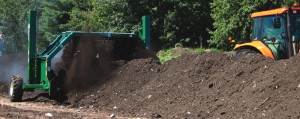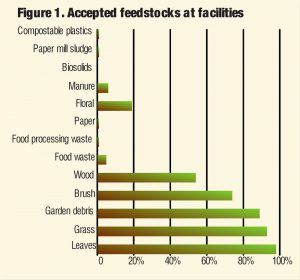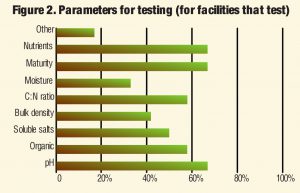Survey of the state’s facilities shows the majority utilize turned windrows, and are mostly composting yard trimmings, garden debris and brush.
Joe Van Rossum
BioCycle October 2012, Vol. 53, No. 10, p. 25
 The University of Wisconsin-Extension Solid & Hazardous Waste Education Center (SHWEC) based in Madison, Wisconsin, recently conducted a survey of composting facilities licensed by the Wisconsin Department of Natural Resources (DNR). The composting industry continues to grow in Wisconsin — from 168 in 2007, when SHWEC last conducted this survey — to 239 facilities today. These operations transform yard trimmings, food scraps, landscape debris and other compostable materials into a valuable compost product used across the state.
The University of Wisconsin-Extension Solid & Hazardous Waste Education Center (SHWEC) based in Madison, Wisconsin, recently conducted a survey of composting facilities licensed by the Wisconsin Department of Natural Resources (DNR). The composting industry continues to grow in Wisconsin — from 168 in 2007, when SHWEC last conducted this survey — to 239 facilities today. These operations transform yard trimmings, food scraps, landscape debris and other compostable materials into a valuable compost product used across the state.
The 2012 survey was conducted using an online format, which asked facility managers to respond to a total of 28 questions. Contact information, including email address, for the compost facility license holders was obtained from the DNR. This list was used to solicit survey respondents. Facility managers were sent an initial email explaining the purpose of the survey and how the resulting information was to be shared. A total of 97 responses (out of 239 emailed) were received for a 41 percent response rate. Responses from publicly owned facilities were higher than privately owned sites (only 15% of survey respondents whereas 23% of composting sites in the state are privately licensed). In addition, a number of licensed sites reported they were not doing any composting, but rather serving as a collection point and transferring materials to other compost facilities.
Size, Volume, Feedstocks, Operations
Composting facilities were asked to describe the size of their site as well as the volume of material accepted on an annual basis. Responses to site size ranged from very small (0.25 acres) to quite large (80 acres). The average size was 5.4 acres.
An equally wide variation was seen in the volume of materials accepted — from less then 50 cubic yards (cy)/year (yr) to 60,000 cy/yr with an average of 6,300 cy/site/yr.
 Types of feedstocks accepted were also reported. Respondents were given the choice of 13 different materials as well as the option to write in additional items. The results are presented in Figure 1. Leaves and grass are by far the most common materials composted, followed by garden debris, brush and wood. Only a handful of sites compost food waste. When asked if their facility accepts compostable bags, 12 percent indicated yes and 88 percent said no.
Types of feedstocks accepted were also reported. Respondents were given the choice of 13 different materials as well as the option to write in additional items. The results are presented in Figure 1. Leaves and grass are by far the most common materials composted, followed by garden debris, brush and wood. Only a handful of sites compost food waste. When asked if their facility accepts compostable bags, 12 percent indicated yes and 88 percent said no.
The survey asked about various management strategies in practice at composting sites. More than half (52%) of sites reported using turned windrows as their primary method of composting. The next most common practice was to compost in static piles (26%), with only 6 percent of facilities using aerated static piles. The remainder (16%) falls into the “other” category (including grinding only and transferring to another site).
Temperature is one of the basic process control measurements commonly monitored by composting facilities. Sixty-seven percent of facilities do not monitor temperatures; 20 percent monitor intermittently, and 13 percent take pile temperatures on a regularly scheduled basis. Based upon this information one can infer the majority of sites are minimally managed. This is expected to change, as the newly revised state regulations require composting sites to monitor and record compost pile temperatures.
Thirteen percent of sites indicated tests are performed on their finished compost. Those indicating they test were asked what parameters are being measured (Figure 2). The most common parameters are nutrients, maturity and pH, followed by C:N ratio and organic matter.
 Tip Fees, Compost Sales, Training
Tip Fees, Compost Sales, Training
Thirteen percent of the composting facilities responding charge facility users a tipping fee on a per ton or per truckload basis. Those charging by the ton ranged from $3/ton to $30/ton. For those charging by the truckload fees were between $2 and $40.
There are still more composting facilities that are giving away or not selling the compost they make. Only 23 percent reported selling their product in either bulk or bagged form. On the other hand, 65 percent reported utilizing the compost they make for their own use, including municipal projects (42%) and creating soil blends (22%).
For those selling in bulk form, prices ranged from $1/cy up to $38/cy. The average price was $13.09/cy. Those selling compost in bagged form (5% of respondents) reported an average selling price of $7.19/bag with prices ranging between $3 and $14. All facilities selling in bags reported bagged compost is less than 25 percent of the total volume of compost being sold. Bulk sales still make up the major portion of compost sales in Wisconsin.
The final two questions on the survey focused on the educational needs of compost facility operators. Almost three-quarters (72%) of respondents indicated they were interested in training opportunities, including, additional information on the newly revised state regulations for composting sites, the basics of composting and compost marketing.
Average Facility Profile
So what does an “average” composting facility look like in Wisconsin? It would have two employees and be about 5.5 acres in size. The site would receive about 6,300 cy/year of leaves, grass clippings and garden debris. The material would predominantly be coming from residential sources with no tipping fee being charged to facility users. The materials would be placed into windrows in most cases, but some would be left in static piles to decompose over the course of 16 months. Resulting compost would then be used by the facility for municipal projects or given away to residents. Occasionally some of the compost product would be screened and tested before it was sold in bulk form at $13/cy.
The survey results found some changes over the past 5 years. The percentage of facilities monitoring compost piles for temperature has risen from 20 percent in 2007 to 33 percent in 2012. The number of facilities charging a tip fee has risen from 6 percent in 2007 to 13 percent in 2012. Also, a few more composters are getting paid for the compost they make. In 2007 only 19 percent reported selling the compost compared to 23 percent in this survey. The average price received for compost products has increased from an average of $9.22/cy in 2007 to $13.09/cy today.
Joe Van Rossum is a recycling specialist with the University of Wisconsin-Extension Solid & Hazardous Waste Education Center (SHWEC) in Madison, Wisconsin (joseph.vanrossum@ces.uwex.edu). SHWEC provides support and resources to assist large-scale composting facility operators.










